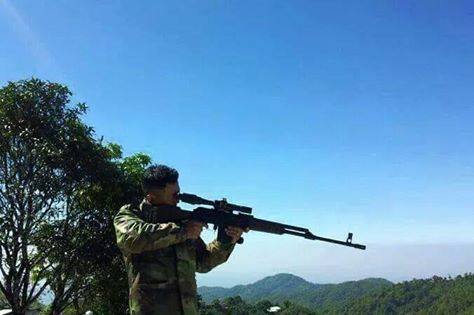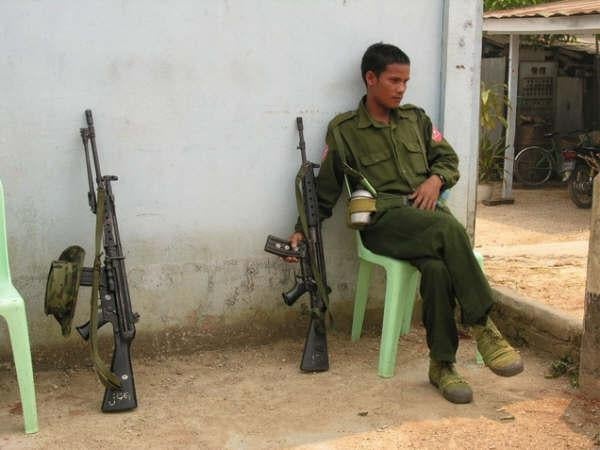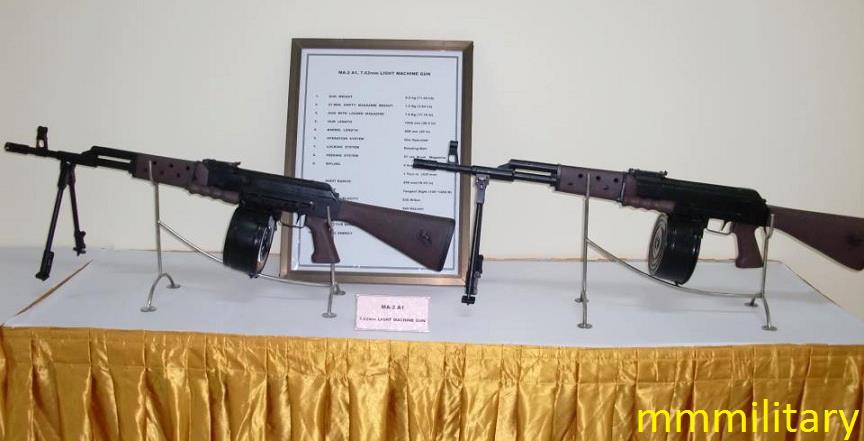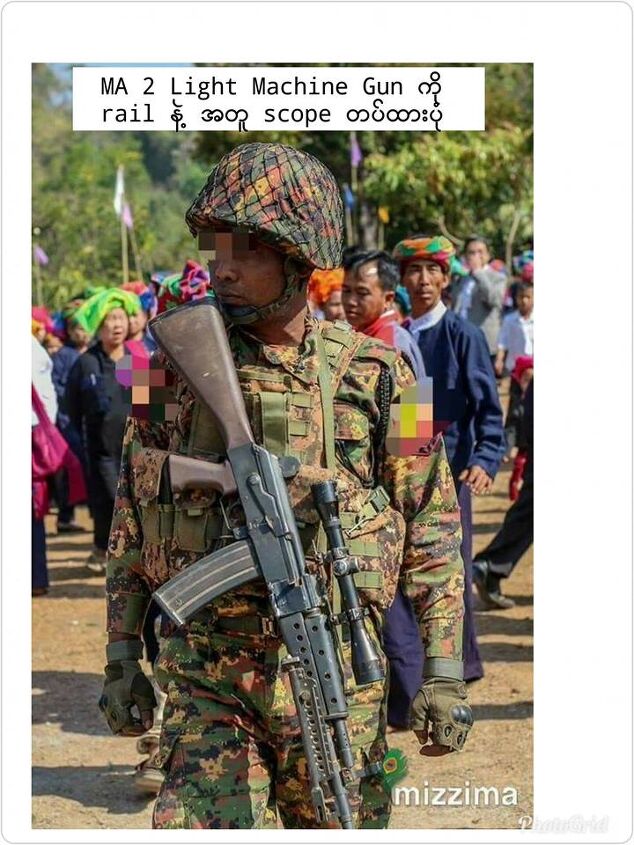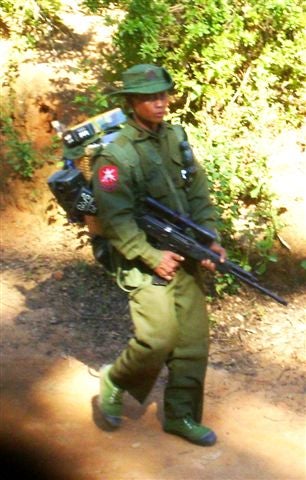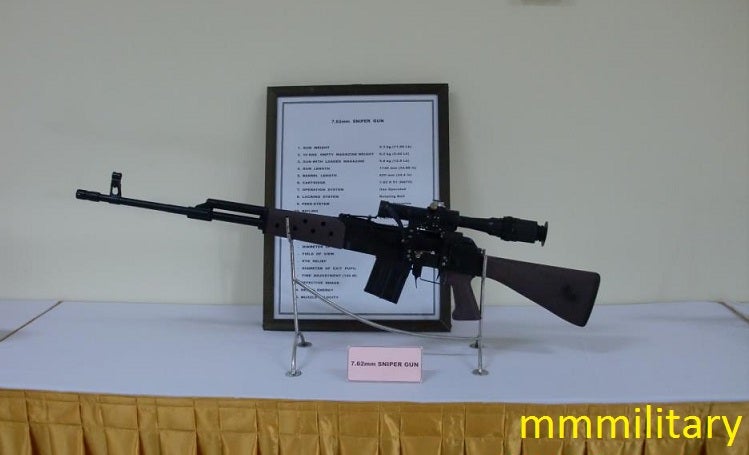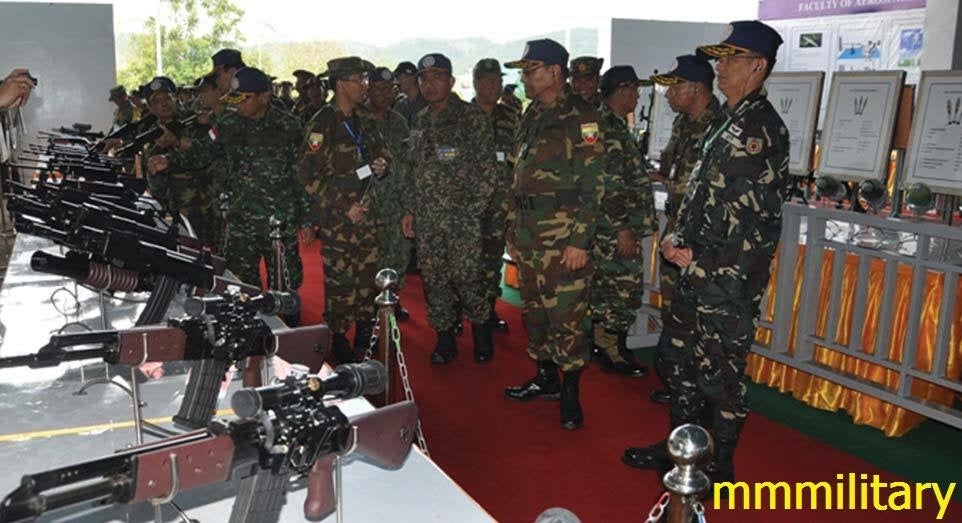During the age of the G3, manufactured in Burma by Defense Industries under contract from Heckler & Koch through the West German company Fritz Werner, the Tatmadaw produced a designated marksman variant. It was called the BA-100 (Burma Army-100) and was the fourth variant of the locally produced G3 series, others being the BA-63 (full-length rifle), BA-64 (LMG variant with heavy barrel, bipod, extended charging handle, carrying handle, and enhanced handguard), and the BA-72 (short rifle variant with shortened barrel and handguard). But when it comes to the BA-100 we actually don’t have a single photograph to research the weapon system from. We do know that the 7.62x51mm rifle had a telescopic scope mounted to it, most likely of commercial off the shelf manufacture from a NATO country origin as Burma was seen as a front against Chinese communism and was thus allotted foreign military supplies and sales. These most likely would have been mounted to an H&K patterned claw mount, possibly imported (not produced locally). When it comes to the reliability of these rifles we have at least one Burmese veteran who claims that the rifles were little more than production BA-63s with optics mounts attached to them. Apparently, they weren’t liked very much as they weren’t accurate and presumably didn’t make too much of a difference in actual combat operations against the ethnic groups.
The Tatmadaw TO/E called for 8 BA-100s to be issued at the battalion level with a “Sniper Section” that was a part of the security platoon attached to the battalion headquarters company of a Light Infantry Battalion (LID). Ammunition allotment is stated in field manuals as 120 rounds issued to each DM, but it should be noted that this is also the same combat load as what the infantrymen issued the BA-63 rifles carried. Commanding this platoon was an NCO known in Burmese as the “Sniper Platoon Sergeant”. We don’t have any record of an officer assigned to this billet from the records so far. A very important note here is that when it comes to TO/E, the Tatmadaw is notorious for not following it, even when looking at basic organization. Many LIBs, although call for a strength of several hundred infantrymen are sometimes known to have less than 50-100 troops in non-combat areas. Reasons for this vary, but it could be a type of deception against enemies by having LIBs stationed throughout the country but simply moving troops between them at times. This would always keep an enemy guessing LIB troop movements and numbers rather than confidently knowing the approximate strength of any given battalion in the field. When it comes to sniper sections the answer is no different when it comes to actual field conditions. This might support the scant evidence of the existence of BA-100s in historical photographs throughout Tatmadaw media.
However, this arrangement is the official TO/E and doctrine established on paper through Burmese field manuals up until the early 2000s. The Tatmadaw changed rifle systems entirely from the BA-63/64/72/100 series in the late 1990s, first to the short-lived MA-11 rifle/MA-12 LMG (5.56mm HK33-patterned), then completely transitioning to the MA-1/2/3/4 family of rifles, light machine guns, and grenade launchers in the very early 2000s. During this transition period, we have scant evidence of a new designated marksman rifle despite the introduction of two weapon system families. When it comes to a precision rifle capability it is hypothesized that the early 7.62x51mm BA-100 rifles were maintained and issued out as needed. This was done with BA-63 rifles and BA-72 carbines in rear echelon positions until the MA-series reached full issue throughout the Army (the BA-series and the MA-11/12 were pushed to national police and people’s militia issue).
Replacing the BA-100 was still seen as an important task and this began with the MA-2 LMG. Similar to some other Kalashnikov weapon system users, it appears to have been summarized that since the MA-2 LMG already had a longer, slightly heavier barrel and firm bipods, it would be a good stock production system to base a precision rifle off of. In addition to the MA-2 being modified, we do have some examples of Defense Industries modifying a standard length MA-1 rifle with a commercial scope mounted on a Kalashnikov-patterned receiver attached side mount. We could jump to conclusions and claim it as a PSO-1, but from the media that we’ve gathered there isn’t enough resolution to affirmatively make this assumption.
Apart from modifying an MA-1 rifle and mounting a scope to the MA-2, we have development of a 7.62x51mm light machine gun that wasn’t standardized to replace the MA-2 but has been seen in use in the field by a BA soldier in the designated marksman role. It is different from the standard stamped MA-2 (which would later be milled) in moving the rear sight to the gas block in a traditional Kalashnikov setting, changing the gas block to a Kalashnikov-patterned one, attaching a side optics mount to the receiver, using a brown carrying handle and taking a 7.62mm drum similar in design concept to an RPK drum. This was called the MA-2A1 in some photographs of the design. Taking this base design, Defense Industries appears to have dropped the bipod, added a PSO-patterned optic, attached a 10 round magazine and labelled this a “7.62mm SNIPER GUN” in displays we have seen of it. Interestingly both of these designs feature the straight cheekpiece of the MA-series that would become standardized (early MA-series have a curved cheekpiece).
The 10 round magazine initially appears to have been a straight walled metal design, but this was changed to a curved polymer version with a “waffle” pattern for ribs and gripping surface that appears to have been upgraded to 20 rounds instead of 10. This design stuck with the program and continues to appear on MA-S rifles today. It also has appeared in the MA-1 Mk III bullpup rifle with a similar polymer waffle pattern. When it comes to field use of this “7.62mm Sniper Gun” we only have one confirmed sighting of it in the field. It probably didn’t see more than several dozen produced either.
 Your Privacy Choices
Your Privacy Choices
